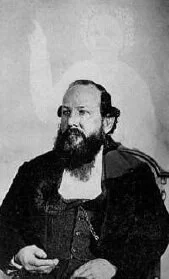How capturing ghosts on film got its start and the fascination we have with ghost photographs...
Written by Robert Irving, the following excerpt from 'Capturing the Spirit' (Fortean Times March 2000) explores "the development of this art form and how 20th century technology has changed it."

What Was the First Ghost Photo?
The First Ghost Photos
The earliest reference to the art of capturing ghosts on film was made in 1856 by the Scottish scientist Sir David Brewster. In a paper entitled 'Application of the Stereoscope for Purposes of Amusement', he described a photograph featuring the transparent shade of a man who had moved from view during a lengthy time exposure. By such illusion, writes Brewster, we may enter the realm of the supernatural.
 His observation preceded the Victorian obsession with spiritualism and demonstrates how artifice can influence phenomena it is subsequently assumed to mimic. The first 'genuine' ghost photograph appeared some years later - the see-through trace of a woman identified as the deceased wife of a Polish aristocrat. Amusement turned to amazement as reports circulated, and it was in this climate that William Mumler established, in the 1860s, the skillful business of phantom portraiture.
His observation preceded the Victorian obsession with spiritualism and demonstrates how artifice can influence phenomena it is subsequently assumed to mimic. The first 'genuine' ghost photograph appeared some years later - the see-through trace of a woman identified as the deceased wife of a Polish aristocrat. Amusement turned to amazement as reports circulated, and it was in this climate that William Mumler established, in the 1860s, the skillful business of phantom portraiture.
(Note: Seen here is the first American ghost photograph on record. It was taken by William Mumler in 1861 in Boston, possibly, by accidental plate error. At least he believed that at first. But those who saw the photo believed it was his deceased cousin in the background behind the bearded man. And so, the 'ghost photo business' of Mumler was born.)
From Art Form to Experiments in the Supranatural
Photography developed from its infancy as the infallible record of nature into a means of creative expression, introducing a new breed of artist. Like traditional artists, photographers were compelled to alter our perception of nature. The camera was considered a purely scientific tool, beyond human interference - so like scientists, photographers Were regarded as a trusted elite. Any anomaly captured on film Was presented as - and taken for - an objective reality, boosting the popularity of ghosts, fairies, angels and UFOs. Thus, in a period of stifling Realism, photography reawakened that part of us blind to common sense, where reality and imagination do not conflict, and object and image are synonymous.
As with nature, the supernatural could be captured, certified and defined With visual language. Our appraisal of imagery -  whatever the subject - accords with established understanding. Some of the most successful ghost photographs, for example, feature stairways (perhaps implying transcendence and escape) as a validating backdrop, a confirmation of genuineness. Like any language, the syntax adapts and evolves over time to shape the environment on which it feeds. But the visual transcendence promised by Mumler et al rarely delivered - surely the spirit world was not populated entirely by camera-conscious posers?
whatever the subject - accords with established understanding. Some of the most successful ghost photographs, for example, feature stairways (perhaps implying transcendence and escape) as a validating backdrop, a confirmation of genuineness. Like any language, the syntax adapts and evolves over time to shape the environment on which it feeds. But the visual transcendence promised by Mumler et al rarely delivered - surely the spirit world was not populated entirely by camera-conscious posers?
Inevitably, Victorian formality was outpaced by artistic movement as photographers refined their techniques. Moreover, to accept the cameras view as reality is to forget that not everything we see is real. Photography is inherently surreal and human interaction ensures its artistic status. As historian Rolf H Krauss observes, photography has always contained, inbuilt, 'a false bottom, an element of the irrational which enticed (us) to delve into the spheres of the unconscious and the invisible.'
Appearance of Anomalies in Ghost Pictures
Interestingly, 19th century scientists were much less inhibited. Inspired by Franz Mesmer's assertion that the ethereal 'life force' is luminescent (and therefroe visible to those sensitive enough), many saw photography as the ideal means to see into nature's reflections. For example, in the 1860s, the eminent Carl von Reichenbach, having formulated paraffin-wax and creosote, turned his attention to the study of 'od', the fluidal breath of emotion which, he believed, radiates from all things. His cameraless experiments with photographic emulsion foreshadow the discovery of X-rays 30 years later, Darget's V-rays, and Blondlots N-rays, etc.
Likewise, the gynecologist and mesmerist Dr. Hippolyte Baraduc produced a book of photographs illustrating the reality of such theosophical interaction as melancholy, the ecstasy of prayer and (sensibly keeping a camera handy for those once-in-a-lifetime moments) 'spirit orbs' departing the body of his dying wife.  Undefined blobs and wisps on film could no longer be dismissed as mere chemical aberration. To Baraduc (as immortalized in his title), they were traces of The Human Soul, its Movements, its Luminosity and the Iconography of the Fluidal Invisible.
Undefined blobs and wisps on film could no longer be dismissed as mere chemical aberration. To Baraduc (as immortalized in his title), they were traces of The Human Soul, its Movements, its Luminosity and the Iconography of the Fluidal Invisible.
If not great science, it was sublime art, for out of this curious visual borderline between science and the occult came the beginnings of modern abstract painting. Supernaturalists never did keep up with the change, continuing to add their own interpretations to accidental blobs or wisps on film. In this, though, they share with early photographers the pleasure of entertaining the unknown and indefinable - a magical, creative activity. With today's emphasis on perfecting photography and eliminating mishap, much of that magic is lost.
